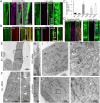Clathrin plaques and associated actin anchor intermediate filaments in skeletal muscle
- PMID: 30601711
- PMCID: PMC6589689
- DOI: 10.1091/mbc.E18-11-0718
Clathrin plaques and associated actin anchor intermediate filaments in skeletal muscle
Abstract
Clathrin plaques are stable features of the plasma membrane observed in several cell types. They are abundant in muscle, where they localize at costameres that link the contractile apparatus to the sarcolemma and connect the sarcolemma to the basal lamina. Here, we show that clathrin plaques and surrounding branched actin filaments form microdomains that anchor a three-dimensional desmin intermediate filament (IF) web. Depletion of clathrin plaque and branched actin components causes accumulation of desmin tangles in the cytoplasm. We show that dynamin 2, whose mutations cause centronuclear myopathy (CNM), regulates both clathrin plaques and surrounding branched actin filaments, while CNM-causing mutations lead to desmin disorganization in a CNM mouse model and patient biopsies. Our results suggest a novel paradigm in cell biology, wherein clathrin plaques act as platforms capable of recruiting branched cortical actin, which in turn anchors IFs, both essential for striated muscle formation and function.
Figures







Similar articles
-
Dynamin-2 mutations linked to Centronuclear Myopathy impair actin-dependent trafficking in muscle cells.Sci Rep. 2017 Jul 4;7(1):4580. doi: 10.1038/s41598-017-04418-w. Sci Rep. 2017. PMID: 28676641 Free PMC article.
-
Plectin 1 links intermediate filaments to costameric sarcolemma through beta-synemin, alpha-dystrobrevin and actin.J Cell Sci. 2008 Jun 15;121(Pt 12):2062-74. doi: 10.1242/jcs.021634. Epub 2008 May 27. J Cell Sci. 2008. PMID: 18505798
-
A mutation associated with centronuclear myopathy enhances the size and stability of dynamin 2 complexes in cells.Biochim Biophys Acta. 2014 Jan;1840(1):315-21. doi: 10.1016/j.bbagen.2013.09.001. Epub 2013 Sep 7. Biochim Biophys Acta. 2014. PMID: 24016602 Free PMC article.
-
Progress in desmin-related myopathies.J Child Neurol. 2000 Sep;15(9):565-72. doi: 10.1177/088307380001500901. J Child Neurol. 2000. PMID: 11019786 Review.
-
Structural insights into the centronuclear myopathy-associated functions of BIN1 and dynamin 2.J Struct Biol. 2016 Oct;196(1):37-47. doi: 10.1016/j.jsb.2016.06.015. Epub 2016 Jun 23. J Struct Biol. 2016. PMID: 27343996 Free PMC article. Review.
Cited by
-
Dual clathrin and integrin signaling systems regulate growth factor receptor activation.Nat Commun. 2022 Feb 16;13(1):905. doi: 10.1038/s41467-022-28373-x. Nat Commun. 2022. PMID: 35173166 Free PMC article.
-
Centronuclear Myopathy Caused by Defective Membrane Remodelling of Dynamin 2 and BIN1 Variants.Int J Mol Sci. 2022 Jun 3;23(11):6274. doi: 10.3390/ijms23116274. Int J Mol Sci. 2022. PMID: 35682949 Free PMC article. Review.
-
Crosstalk of growth factor receptors at plasma membrane clathrin-coated sites.bioRxiv [Preprint]. 2024 May 18:2024.05.16.594559. doi: 10.1101/2024.05.16.594559. bioRxiv. 2024. PMID: 38903101 Free PMC article. Preprint.
-
Common Pathogenic Mechanisms in Centronuclear and Myotubular Myopathies and Latest Treatment Advances.Int J Mol Sci. 2021 Oct 21;22(21):11377. doi: 10.3390/ijms222111377. Int J Mol Sci. 2021. PMID: 34768808 Free PMC article. Review.
-
Canonical and non-canonical integrin-based adhesions dynamically interconvert.Nat Commun. 2024 Mar 7;15(1):2093. doi: 10.1038/s41467-024-46381-x. Nat Commun. 2024. PMID: 38453931 Free PMC article.
References
-
- Bitoun M, Maugenre S, Jeannet PY, Lacène E, Ferrer X, Laforêt P, Martin JJ, Laporte J, Lochmüller H, Beggs AH, et al. (2005). Mutations in dynamin 2 cause dominant centronuclear myopathy. Nat Genet , 1207–1209. - PubMed
-
- Brodsky FM. (2012). Diversity of clathrin function: new tricks for an old protein. Annu Rev Cell Dev Biol , 309–336. - PubMed
-
- Chorev DS, Moscovitz O, Geiger B, Sharon M. (2014). Regulation of focal adhesion formation by a vinculin-Arp2/3 hybrid complex. Nat Commun , 3758. - PubMed
Publication types
MeSH terms
Substances
LinkOut - more resources
Full Text Sources
Molecular Biology Databases
Miscellaneous

